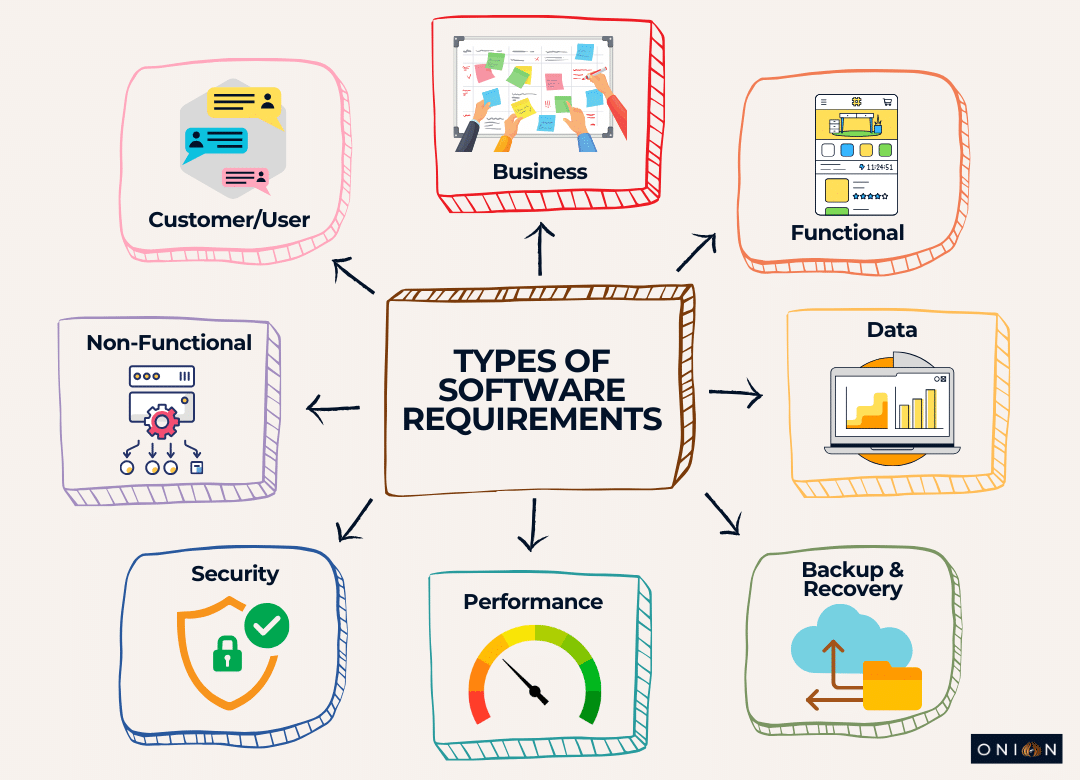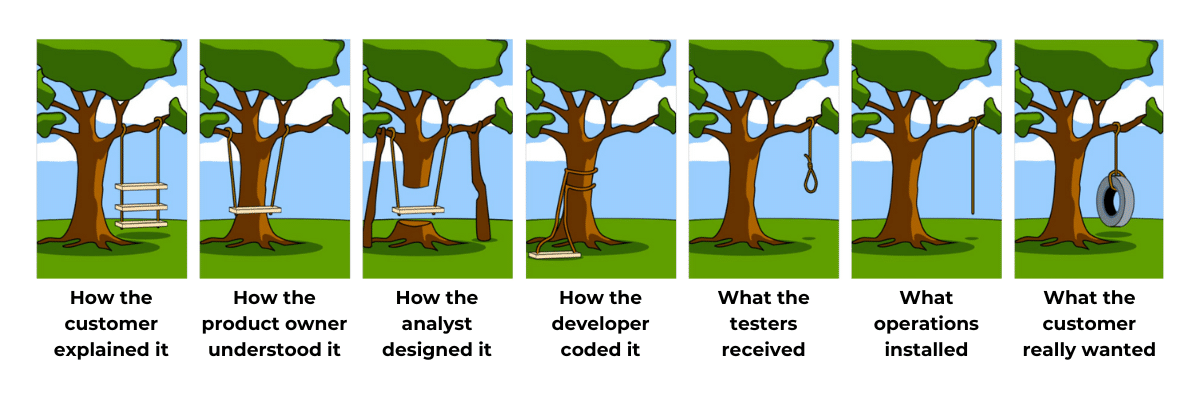In the complex landscape of software development, it is universally acknowledged that the quality of a project begins at its inception — particularly with the clarity and thoroughness of its software requirements.
In 2023, inadequate requirements gathering emerged as the primary reason for project failures, affecting a substantial 39.03% of projects.
Software requirements are more than just a set of instructions; they are the foundational blueprint from which all subsequent activities, from design to deployment, are derived. By ensuring these requirements are clear and comprehensive, a project can significantly minimise risks and enhance its prospects for success. This is precisely where an effective Software Requirements Specification (SRS) proves invaluable.
A Software Requirements Specification (SRS) is a comprehensive document that outlines the expected functionality, features and operational constraints of a software product. This document is foundational to both the development and the successful implementation of the software, acting as a bridge between stakeholders and the technical team.
Table Of Contents
Purpose and Scope of an SRS
The primary goal of an SRS is to ensure that developers and clients are on the same page regarding a software product’s functionalities and constraints before the development phase begins. It provides numerous benefits in software engineering, significantly enhancing project outcomes. Here are six key benefits:
📌Enhanced Communication: A comprehensive SRS serves as a communication tool between stakeholders, including developers, project managers, clients and end-users. It ensures that everyone has a clear understanding of the project requirements and expectations, thereby minimising misunderstandings.
📌Reduction in Development Errors: An SRS provides a detailed description of the functionality and behaviour of the software application, which helps in reducing the development complexity.By clearly defining the requirements before the development starts, an SRS helps in reducing the likelihood of errors during the coding phase. This precise guidance helps developers focus on meeting the exact needs of the project without unnecessary rework.
📌Improved Project Planning: An SRS provides detailed information about the software’s scope, functionalities and limitations, which aids in accurate project scheduling and resource allocation. This thorough planning helps manage project timelines and budgets more effectively.
📌Facilitation of Testing and Validation: A well-structured SRS includes specific criteria that must be met for the software to be considered complete. This makes it easier for quality assurance teams to develop test cases and perform rigorous testing to ensure the software meets all requirements.
📌Control Scope Creep: An SRS helps in defining clear boundaries for the project scope. This documentation is crucial in preventing scope creep, where the scope of the project expands gradually without proper authorisation, often leading to projects going over budget and deadlines being missed.
📌Supports Future Maintenance and Enhancements: An SRS is not only useful during the initial development phase but also serves as a valuable reference for future maintenance and upgrades. It helps new team members understand the project’s initial goals and requirements, facilitating smoother updates and enhancements.
Importance of an SRS
The clarity and scope of software requirements are essential in shaping every phase of the software development lifecycle (SDLC). Ambiguity or gaps in these requirements can trigger a cascade of challenges, leading to project delays, escalated costs and diminished product quality. In stark contrast, clear and comprehensive requirements streamline project workflows, diminish misunderstandings and establish a strong foundation for all project-related activities.
Creating an SRS is a meticulous process that requires deep understanding of the client’s needs and the technical possibilities. It often involves significant collaboration between business analysts, project managers and potential users of the software. Regular reviews and updates to the SRS document may also be necessary as the project evolves and additional requirements emerge.
In practice, the creation of an SRS can be facilitated by various tools and templates that provide a structured approach to capturing requirements. This systematic documentation is not just a blueprint for development but also a guide for future maintenance and enhancement of the software product.
Understanding and implementing a well-structured SRS can significantly impact the success of a software project, ensuring that it meets all user expectations and business requirements efficiently and effectively.

SRS and Business Functions
📢Vision and Scope Articulation: Software requirements are crucial for capturing and conveying the business’s vision. They act as a bridge that translates complex business needs into specific, actionable directives for the development team. This translation is essential for ensuring that all stakeholders, from executives to technical personnel, share a common understanding of the project’s goals and expected outcomes. When software requirements successfully articulate the scope and vision, they synchronise the efforts of diverse teams towards achieving a unified objective, thereby enhancing the project’s efficiency and effectiveness.
📝Guidance for Business Analysts: Business analysts play a key role in defining and refining software requirements to ensure they align with business goals and user expectations. Precise and well-defined software requirements are indispensable tools for these professionals, helping them to delineate and manage the project’s scope and objectives. This careful management is crucial for maintaining the project’s focus on delivering the strategic value expected by stakeholders, avoiding scope creep and ensuring resource allocation aligns with critical business priorities.
🛠️Development Blueprint: For developers, clear software requirements serve as a critical blueprint guiding coding and configuration efforts. When requirements are explicitly stated, the likelihood of misinterpretation or the need for significant rework is greatly reduced. By clearly articulating the requirements, developers have a better roadmap for coding and configuration, which reduces the scope for misinterpretation and rework. This clarity not only boosts development efficiency but also enhances adherence to project timelines. Developers can focus more on innovation and quality, rather than deciphering vague requirements, which in turn leads to a more robust and reliable software product.
🕵🏻Basis for Testing and Verification: In the testing phase, the quality of software requirements becomes manifestly evident. Testers rely on these requirements to form the basis of their test cases and validation criteria. This reliance is fundamental to ensure the software not only functions as intended but also adheres to the specified standards and user needs. Clear requirements allow for the development of precise and comprehensive testing protocols, which are critical for verifying the software’s functionality, performance and security before it reaches the end-users. Effective testing, guided by well-defined requirements, is integral to maintaining high quality and achieving user satisfaction in the final product.
📑Framework for Documentation: Finally, software requirements are instrumental in creating detailed documentation for the software product. This documentation, which includes user manuals, system documentation and help files, is essential for supporting end-users and guiding them in effectively utilising the software. Additionally, complete documentation is crucial for future maintenance efforts and scalability enhancements. It serves as a reference that developers and maintenance teams use to understand the software’s intended functionality and underlying architecture, which is particularly valuable during upgrades or troubleshooting.
The Downstream Effects of Requirement Clarity

The importance of clarity in software requirements cannot be overstated. When requirements are not sufficiently detailed or are misunderstood, the project can deviate significantly from its intended course. This deviation can lead to features that do not meet user expectations or business needs, potentially resulting in software that is functionally inadequate or misaligned with market demands.
Additionally, unclear requirements often lead to iterative cycles of revisions and fixes, which can inflate costs and extend deadlines. In worst-case scenarios, it may even necessitate complete redevelopment phases if the delivered product fails to meet critical business needs or regulatory requirements. This not only affects the budget but also impacts the overall market responsiveness and competitiveness of the business.
Long-Term Impacts of Solid Software Requirements
The long-term benefits of investing time and effort into developing clear SRS are manifold. Firstly, they provide a durable reference that aids all stakeholders in understanding the software’s functionality and scope throughout its operational life. Secondly, solid requirements help in scaling and modifying the software as business needs evolve, ensuring longevity and adaptability of the solution.
Strategies for Enhancing Software Requirements Quality
To maximise the effectiveness of software requirements, several strategies can be employed:
- Stakeholder Engagement: Engaging with all relevant stakeholders during the requirement-gathering phase is crucial. This includes not just the business owners and end-users but also the IT support teams who will maintain the software post-deployment.
- Utilisation of Models and Prototypes: Visual models and prototypes can be extremely helpful in clarifying requirements. They provide a tangible representation of the software, helping stakeholders envision the final product and refine their requirements before development begins.
- Continuous Validation: Software requirements should be regularly reviewed and validated throughout the project lifecycle. This iterative process ensures that the requirements continue to align with business goals and user needs, even as these evolve.
- Training and Best Practices: Regular training sessions on the best practices in requirement documentation such as the SRS can enhance the skills of those involved in the requirements gathering process. This is particularly important in dynamic industries where trends and technologies are constantly evolving.
In summary, software requirements are the foundation upon which successful software projects are built. They influence every phase of the software development lifecycle, providing clarity, direction and a framework for all subsequent activities. By ensuring these requirements are detailed, clear and continually aligned with business objectives, organisations can not only avoid the pitfalls of ambiguity and misinterpretation but also enhance the overall quality and effectiveness of their software solutions. Ultimately, embracing a meticulous and proactive approach to developing software requirements will mitigate risks and pave the way for project success, firmly establishing that indeed, software quality begins with clarity in requirements.
If you’re new to software testing and eager to delve deeper into SRS and other functions in the software lifecycle as part of your learning journey, make sure to subscribe to our newsletter for more detailed insights and guidance.
Related Articles
Become A Quality Assurance Tester: 5 Must-Know Tips
6 Benefits of Well-Documented Software Requirements for Successful Projects
16 Undeniable Reasons Why AI in Software Testing Cannot and Will Not Replace Software Testers

